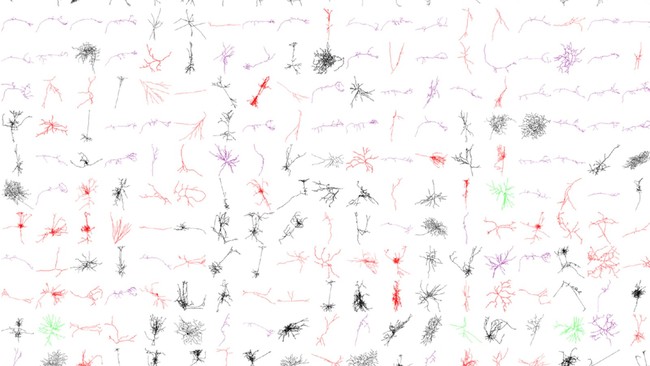
Over 180,000 neural reconstructions, corresponding to millions of labor person-hours, can be browsed, searched, and downloaded by animal species, brain region, and many user-defined criteria thru NeuroMorpho.Org’s web interface and API. Scientific applications of the shared data yielded hundreds of published research results by independent labs in comparative analysis, computational modeling, machine learning, advanced visualization, and unbiased classification. NeuroMorpho.Org data sharing is a multidisciplinary effort involving collection, standardization, and annotation of reconstructions and metadata into an open-access database. The recent automation of this process has enabled increased data sharing capacity and community engagement.
Giorgio Ascoli is NeuroMorpho.Org’s founding PI. He collated the first 1k reconstructions by peer-to-peer exchange and worked with students and colleagues to create a relational database and launch a web-based interface for dynamic queries and data retrieval in 2006. As the project needs and data flow expanded with growing community usage, he hired Carolina & Bengt to bring this resource to the next level.
Carolina Tecuatl joined the Ascoli Lab in 2018 as postdoc from Univ. Autonoma (Mexico). As project data manager, she is responsible for evaluating new publications with relevant data, processing and quality-controlling reconstructions, and extracting metadata. Carolina trains and supervises many Mason neuroscience and bioengineering undergraduates and works with Giorgio & Bengt to release new data to the community.
Bengt Ljungquist joined the team in 2019 as IT manager from Lund Univ. (Sweden) with a cross-disciplinary background: Computer Science MSc, Neuroscience PhD, and 8 yrs teaching medical school. As project technical lead, he ensures the operational stability of database & web platform, oversees progressive automation to enable increasing data volume, and works with Carolina & Giorgio to maximize public data accessibility.
Launched 16 years ago with just 932 reconstructions from 7 animal species and 23 labs, NeuroMorpho.Org recently passed 180k 3D arbor tracings from >90 species, from C. elegans to human, and 900+ labs worldwide (links in Supporting Documentation). These freely available data span >1400 cell types and 400 vertebrate and invertebrate brain regions. Thru a systematic pipeline, we review, annotate, and standardize all reconstructions, readying them for independent applications. More than 30M downloads have yielded >700 publications in computational modeling, comparative morphology, and more, with breakthroughs including the discovery of cell-type specific differences across mouse, monkey, and human brain; identifying systematic patterns of structured connectivity in stochastically assembled neural circuits; and predicting neurological radiation damage of cancer radiation therapy or long-haul space travel.
If peer-reviewed publications provide an index of retrospective utilization, grant applications and awards typically reflect prospective usage. NIH has received >366 applications mentioning NeuroMorpho in key sections (titles, specific aims, and summary statements) from 255 PIs and 124 organizations; 142 of these applications have been funded (~$246M).
As a key ingredient for success, NeuroMorpho.Org always makes data and metadata freely available for download, with no registration required, demonstrated by 3,100,000 accesses from 210 countries. Another important strategy has been to enable both human access through a user-friendly graphical interface with browse and search capabilities, and programmatic access via API with structured methods and data filtering. The progressive automation of data collection, annotation, processing, and publishing has increased data throughput by leveraging machine learning and modern cloud computing. NeuroMorpho.Org also provides immediate value to the broader community with 1-click accessible 2D, 3D, and interactive visualizations of all published neurons and glia. Consequently, in addition to extensive scientific usage, NeuroMorpho.Org is used as an educational resource in high school, college, online labs, and web courses, and has inspired numerous multimedia artistic renderings including illustrations, sculptures, and audiovisual exhibits. Applications also exist in the private sector: DRVision Tech developed and launched in 2017 their best-selling image analysis product, AIVIA5, using NeuroMorpho.Org for algorithm training.
We implemented open-source software to import all known (30+) file formats by any commercial or non-profit morphological tracing system (Neurolucida, Imaris, Amira, Simple Neurite Tracer, NeuronJ, Knossos, NeuTube, Vaa3D, Trees Toolbox). All reconstructions provided by the authors undergo a consistent workflow of conversion, standardization, and quality control. These processes are largely automated but always proof-checked by trained curators under our direct supervision. Both original and processed data are always publicly released with change logs and residual notes. Every reconstruction is also annotated with rich metadata extracted by automated text mining and manual expert curation. Authors can proof their data on a private review site before release.
NeuroMorpho.Org reconstructions are downloadable as .swc-files, a data format whose community standardization our team is leading with the International Neuroinformatics Coordinating Facility following FAIR principles. All our data processing tools and entire pipeline are on GitHub, allowing full replicability, but also catalyzing a synergistic community ecosystem of complementary resources.
Many external sites replicate parts of NeuroMorpho.Org’s content in new applications accelerating scientific discovery, such as an external service to 3D-print neuron models; the Blue Brain Project’s Hippocampus Hub; and multiple informatics pipelines enabling interactive queries, analyses, and simulations directly from NeuroMorpho.Org.
Neuroscientists are notoriously reluctant to share data. NeuroMorpho.Org helped change this attitude by endowing datasets with a second life thru repeated reuse, multiplying the original research impact. In the project’s first 3 years, <20% of authors agreed to share their data, but this fraction steadily increased and soared above 80% in the last 3 years. Thus, ~2/3 of neural morphologies ever reconstructed since the dawn of digital tracing (1985) are now publicly available via NeuroMorpho.Org. Instead of relying on top-down sharing mandates, we pioneered a strategy of transparent online posting of all data requests and their outcomes. We then implemented machine learning approaches to identify every re-usage of individual datasets in peer-reviewed publication, quantifying the ‘added-value’ of each contributing lab. Authors can use this information for career promotions, merit raises, award nominations, and grant renewals; funding agencies can track the impact of their portfolios.
Overall, 731 peer-reviewed publications used downloaded reconstructions, another 1964 described data available thru the database, 41 more were about the project itself, and 703 additional ones cited NeuroMorpho.Org as exemplary data sharing resource.